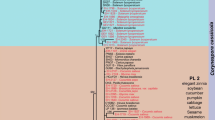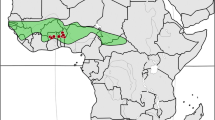Abstract
Ascochyta/legume interactions are attractive systems for addressing evolutionary questions about the role of host specificity in fungal speciation because many wild and cultivated cool season food legumes are infected by Ascochyta spp. and most of these fungi have described teleomorphs (Didymella spp.) that can be induced in the laboratory. Recent multilocus phylogenetic analyses of a worldwide sample of Ascochyta fungi causing ascochyta blights of chickpea (Cicer arietinum), faba bean (Vicia faba), lentil (Lens culinaris), and pea (Pisum sativum) have revealed that fungi causing disease on each host formed a monophyletic group. Host inoculations of these fungi demonstrated that they were host-specific, causing disease only on the host species from which they were isolated. In contrast to the strict association between monophyletic group and host observed for pathogens of cultivated legumes, Ascochyta fungi causing disease on wild bigflower vetch (Vicia grandiflora) were polyphyletic. Genetic crosses between several pairs of closely related, host-specific, and phylogenetically distinct Ascochyta fungi were fully sexually compatible. Progeny from these crosses had normal cultural morphology and segregation of molecular markers indicating a lack of intrinsic, post-zygotic mating barriers between the parental taxa. However, when progeny from a cross between a faba bean-adapted isolate (A. fabae) and a pea-adapted isolate (A. pisi) were assessed for their pathogenicity to the parental hosts, almost all progeny were non-pathogenic to either faba bean or pea. These results suggest that although these fungi have retained the ability to mate and produce progeny with normal saprophytic fitness, progeny are severely compromised in parasitic fitness. The host specificity of these fungi, coupled with the inability of hybrid progeny to colonize and reproduce on a host, may constitute strong extrinsic, pre-zygotic and post-zygotic mating barriers in these fungi and promote the genetic isolation and speciation of host-specific taxa. A phylogeny of the host plants is also being developed, and with more extensive sampling of pathogens and hosts from sympatric populations in the centre of origin, the hypothesis of cospeciation of pathogens and hosts will be tested. The objectives of this review are: (1) to summarize recent phylogenetic, host specificity and speciation studies of Ascochyta fungi, and (2) to suggest how current and future research using these pathosystems may lead to a better understanding of the role of host specificity in the speciation of plant-pathogenic fungi and the cospeciation of pathogens and their hosts.


Similar content being viewed by others
References
Barve, M. P., Arie, T., Salimath, S., Muehlbauer, F. J., & Peever, T. L. (2003). Cloning and characterization of the mating type (MAT) locus from Ascochyta rabiei (teleomorph: Didymella rabiei) and a MAT phylogeny of legume-associated Ascochyta spp. Fungal Genetics and Biology, 39, 151–167.
Cherif, M., Chilvers, M. I., Akamatsu, H., Peever, T. L., & Kaiser, W. J. (2006). Cloning of the mating type locus from Ascochyta lentis (teleomorph: Didymella lentis) and development of a multiplex PCR mating assay for Ascochyta species. Current Genetics, 50, 203–215.
Dey, S. K., & Singh, G. (1994). Seedborne infection of Ascochyta rabiei in chickpea and its transmission to aerial plant parts. Phytoparasitica, 22, 31–37.
Fatehi, J., & Bridge, P. (1998) Detection of multiple rRNA-ITS regions in isolates of Ascochyta. Mycological Research, 102, 762–766.
Giraud, T., Villareal, L. M. M. A., Austerlitz, F., Le Gac, M., & Lavigne, C. (2006). Importance of the life cycle in sympatric host race formation and speciation of pathogens. Phytopathology, 96, 280–287.
Goodwin, S. B., & Fry, W. (1994). Genetic analyses of interspecific hybrids between Phytophthora infestans and Phytophthora mirabilis. Experimental Mycology, 18, 20–32.
Goodwin, S. B., Legard, D. E., Smart, C. D., Morris, L., & Fry, W. (1999). Gene flow analysis of molecular markers confirms that Phytophthora mirabilis and P. infestans are separate species. Mycologia, 91, 796–810.
Gossen, B. D., Sheard, J. W., Beauchamp, C. J., & Morrall, R. A. A. (1986). Ascochyta lentis renamed Ascochyta fabae f. sp. lentis. Canadian Journal of Plant Pathology, 8, 154–160.
Heath, M. C. (1991). The role of gene-for-gene interactions in the determination of host species specificity. Phytopathology, 81, 127–130.
Hernandez-Bello, M. A., Chilvers, M. I., Akamatsu, H., & Peever, T. L. (2006). Host specificity of Ascochyta spp. infecting legumes of the Vicieae and Cicereae tribes and pathogenicity of an interspecific hybrid. Phytopathology, 96, 1148–1156.
Hiura, U. (1962). Hybridization between varieties of Erysiphe graminis. Phytopathology, 52, 664–666.
Hiura, U. (1978). Genetic basis of formae speciales of Erysiphe graminis. In D. M. Spence (Ed.), The powdery mildews. London: Academic Press.
Javadi, F., & Yamaguchi, H. (2004). Interspecific relationships of the genus Cicer L. (Fabaceae) based on trnT-F sequences. Theoretical and Applied Genetics, 109, 317–322.
Jellis, G. J., & Punithalingam, E. (1991). Discovery of Didymella fabae sp. nov., the teleomorph of Ascochyta fabae, on faba bean straw. Plant Pathology, 40, 150–157.
Johnson, T. (1949). Intervarietal crosses in Puccinia graminis. Canadian Journal of Research, 227, 45–65.
Kaiser, W. J. (1972). Occurrence of three fungal diseases of chickpea in Iran. FAO Plant Protection Bulletin, 20, 73–78.
Kaiser, W. J. (1973). Factors affecting growth, sporulation, pathogenicity and survival of Ascochyta rabiei. Mycologia, 65, 444–457.
Kaiser, W. J. (1991). Host range studies with the Ascochyta blight pathogen of chickpea. International Chickpea Newsletter, 25, 25–27.
Kaiser, W. J. (1992). Epidemiology of Ascochyta rabiei. In K. B. Singh, & M. C. Saxena (Eds.), Disease resistance breeding in chickpea (pp. 117–134). Aleppo, Syria: ICARDA.
Kaiser, W. J. (1997a). Inter- and intranational spread of ascochyta pathogens of chickpea, faba bean and lentil. Canadian Journal of Plant Pathology, 19, 215–224.
Kaiser, W. J. (1997b). The teleomorph of Ascochyta rabiei and its significance in breeding chickpea. In S. M. Udupa & F. Weigand (Eds.), Application of DNA fingerprinting for crop improvement: Marker-assisted selection of chickpea for sustainable agriculture in the dry areas (pp. 3–21). Aleppo: ICARDA.
Kaiser, W. J., Wang, B.-C., & Rogers, J. D. (1997). Ascochyta fabae and A. lentis: Host specificity, teleomorphs (Didymella), hybrid analysis and taxonomic status. Plant Disease, 81, 809–816.
Khan, M. S. A., Ramsey, M. D., & Scott, E. S. (1999) Host range studies with an Australian isolate of Ascochyta rabiei. Australasian Plant Pathology, 28, 170–173.
Kimber, R. B. E., Scott, E. S., & Ramsey, M. D. (2006). Factors influencing transmission of Didymella rabiei (ascochyta blight) from inoculated seed of chickpea under controlled conditions. European Journal of Plant Pathology, 114, 175–184.
Kohn, L. M. (2005). Mechanisms of fungal speciation. Annual Review of Phytopathology, 43, 279–308.
Maden, S. (1983). Transmission of seed-borne infections of Ascochyta rabiei (Pass.) Lab. to seedlings and its control. Journal of Turkish Phytopathology, 12, 77–82.
Maden, S., Singh, D., Mathur, S. B., & Neergaard, P. (1975). Detection and location of seed-borne inoculum of Ascochyta rabiei and its transmission in chickpea (Cicer arietinum). Seed Science and Technology, 3, 667–681.
Mel’nik, V. A., Braun, U., & Hagedorn, G. (2000). Key to the fungi of genus Ascochyta Lib. (Coelomycetes). Kurfustendamm, Berlin, Arno Brynda, Berlin.
Morrall, R. A. A., & McKenzie, D. L. (1974). A note on the inadvertant introduction to North America of Ascochyta rabiei, a destructive pathogen of chickpea. Plant Disease Reporter, 58, 342–345.
Nene, Y. L., Hanounik, S. B., Qureshi, S. H., & Sen, B. (1988). Fungal and bacterial foliar diseases of pea, lentil, faba bean and chickpea. In R. J. Summerfield (Ed.), World crops: Cool season food legumes (pp. 577–589). Dordrecht, Netherlands: Kluwer Academic Publishers.
Nene, Y. L., & Reddy, M. V. (1987). Chickpea diseases and their control. In M. C. Saxena & R. S. Singh (Eds.), The chickpea (pp. 233–270). Wallingford, Oxfordshire, UK: CAB International.
Paterson, A. M., & Banks, J. (2001). Analytical approaches to measuring cospeciation of host and parasites: through a looking glass, darkly. International Journal for Parasitology, 31, 1012–1022.
Peever, T. L., Barve, M. P., Stone, L. J., & Kaiser, W. J. (2007). Evolutionary relationships among Ascochyta species infecting wild and cultivated hosts in the legume tribes Cicereae and Vicieae. Mycologia, 99, 59–77.
Peever, T. L., Salimath, S. S., Su, G., Kaiser, W. J., & Muehlbauer, F. J. (2004). Historical and contemporary multilocus population structure of Ascochyta rabiei (teleomorph: Didymella rabiei) in the Pacific Northwest of the United States. Molecular Ecology, 13, 291–309.
Smartt, J. (1990). Grain legumes: Evolution and genetic resources. Cambridge UK: Cambridge University Press.
Steele, K. P., & Wojciechowski, M. F. (2003). Phylogenetic analyses of tribes Trifolieae and Vicieae based on sequences of the plastid gene, matK (Papilonoideae: Leguminosae). In B. B. Klitgaard & A. Bruneau (Eds.), Advances in legume systematics, Part 10: Higher level systemtics (pp. 355–370). Kew: Royal Botanic Gardens.
Sudupak, M. A., Akkaya, M. S., & Kence, A. (2004). Genetic relationships among perennial and annual Cicer species growing in Turkey assessed by AFLP fingerprinting. Theoretical and Applied Genetics, 108, 937–944.
Thompson, J. N., & Burdon, J. J. (1992). Gene-for-gene coevolution between plants and parasites. Nature, 360, 121–125.
Trapero-Casas, A., Navas-Cortes, J. A., & Jimenez-Diaz, R. M. (1996). Airborne ascospores of Didymella rabiei as a major source of primary inoculum for Ascochyta blight epidemics in chickpea crops in southern Spain. European Journal of Plant Pathology, 102, 237–245.
Tripathi, H. S., Singh, R. S., & Chaube, H. S. (1987). Host-range of Ascochyta rabiei (Pass.) Labr., the causal agent of Ascochyta blight in chickpea. International Chickpea Newsletter, 16, 11.
Van Der Maesen, L. J. G. (1987). Origin, history and taxonomy of chickpea. In M. C. Saxena & K. B. Singh (Eds.), The Chickpea (p. 409). Oxford, UK: C.A.B. International.
Wilson, A. D., & Kaiser, W. J. (1995). Cytology and genetics of sexual compatibility in Didymella rabiei. Mycologia, 87, 795–804.
Acknowledgements
The author would like to thank Kelly Steele and Martin Wojciechowski, Arizona State University, for providing unpublished data presented in Fig. 2. The author would also like to thank Martin Chilvers, Washington State University, and an anonymous referee for greatly improving the manuscript.
Author information
Authors and Affiliations
Corresponding author
Rights and permissions
About this article
Cite this article
Peever, T.L. Role of host specificity in the speciation of Ascochyta pathogens of cool season food legumes. Eur J Plant Pathol 119, 119–126 (2007). https://doi.org/10.1007/s10658-007-9148-2
Received:
Accepted:
Published:
Issue Date:
DOI: https://doi.org/10.1007/s10658-007-9148-2




